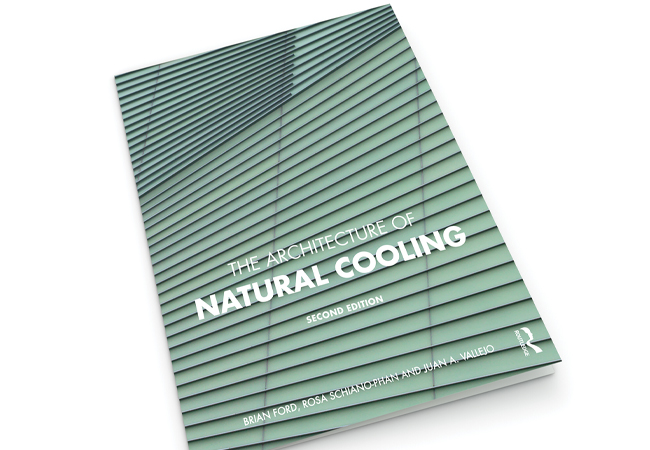
It’s funny, but whatever I do, there is always a bit of prejudice in my head that needs adjusting before I can see things. That was certainly the case as I began reading this book.
I have known the main author, Brian Ford, emeritus professor of architecture at the University of Nottingham, for many years – and, indeed, worked with him on occasion. So I am aware of his ‘rigorous’ architectural approach to ‘natural’ ventilation and consummate dislike of fans and ductwork, and was wondering how his book would go down in a building services journal.
As I read, however, it grew on me. This might be fairly described as an ‘important book’ for both architects and engineers. Specifically, it addresses those wishing to learn how to approach low energy and low carbon building design in a hot world creatively. The title does not cover fully what is at the heart of the book, and why it has importance. Although it is about an
approach to cooling, it is more than that.
With a foreword by Professor Dean Hawkes, The Architecture of Natural Cooling steps through the design process, from empty sheet to the analysis in the case studies. These inspire and warn with their ‘problems encountered and opportunities for improvement’ sections. This is an exemplar of clarity, explaining how environmental engineers and architects can extract exciting architecture from the engineering of comfort – and how to do it with a lightness of touch.

Brian Ford’s book can ‘return pleasure to engineering design’
Throughout, there are little blue boxes highlighting key points. If building services and architectural students only read, absorb and implement these, I would be happy. This discusses different climates where cooling might be needed. The authors explain how to approach a design process that begins before a building form exists to deliver an architecture that is comfortable in hot conditions.
Particularly key is the identification of simple formulae and climate mapping that enable robust early strategic decisions to be made. It is at this very early stage that engineers appear to struggle most to input creatively to design team meetings – but this is also where the most impact can be made with fewest words. If clear, simple, quantitative advice can be well delivered by the engineer, it will help tune an architect’s design intuition. Then, a joint project ambition can be formed that is strong and thoroughly understood by all parties to be carried through the construction of a completed building.
But what is ‘natural cooling’, and is it relevant to the built environment today? As the authors explain, it is ‘the exploitation of natural heat sinks, which include external air, the night sky, the ground and the evaporation of water’. This certainly has wide relevance. There are opportunities to understand these concepts and engineer them at scale.
Key is the identification of the simple formulae and climate mapping that enable robust early strategic decisions to be made
The authors give examples from around the world. Much of the greatest building cooling challenges are in climates other than our own, and many of us will be lucky enough to design in these. With air conditioning use growing rapidly in Asia and Africa, it is vital that we understand the opportunities to develop climate-specific, naturally cooled architectures for these rapidly developing countries.
I am encouraged that a book written by architects introduces climate mapping on a psychometric chart as a point of initial discussion with an engineer when considering a brief. This is to be celebrated. Together with the concept of applicability, mapping to focus the mind quickly on the available opportunities is the way to give us engineers a voice at the pre-design table. We need to grasp this. The other side of the coin is that engineers need to understand enough about architecture and the way architects think to become truly integrated designers.
CIBSE should work with architects on guidance that will enable us jointly to deliver buildings that work, without the unmanageable complexity we seem to introduce. Rather than focusing on ductwork and air handling units to move air, perhaps we should develop better ways to use occupied spaces and the naturally occurring pressure differences, and then know where and how to enhance them. This book opens a door on a world where building structures can be the heat absorber and falling water the heat dissipater; where environmental engineers are welcomed at the design team table before a built form exists.
If you want to understand the possibilities of natural heat sinks, this book is an excellent introduction. The mathematical complexity is carefully limited to just what is required, and no more. It delivers clear guidance on how a collaborative approach to design can be implemented – an approach that, I believe, can return pleasure to engineering design. This is a book about the creative application of building physics and how – done well – it can result in buildings that will be loved and become the built heritage of the future, rather than demolished in 20 years. The future just got brighter for a change. Thank you, guys.
Andy Ford is professor of building systems engineering at London South Bank University

